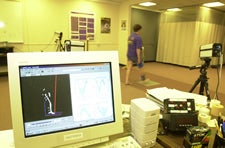Cutting-edge video helps researchers study foot problems of diabetes patients
In Hollywood it’s among the hottest technologies that’s popping up in blockbuster movies such as “The Matrix Reloaded,” “The Lord of the Rings – The Two Towers” and “Spiderman” – giving realistic movement to computer-generated images. At East Carolina University, researchers are tapping into the same motion-capture technology to better understand the devastating side effects of diabetes.
ECU physical therapy faculty are using computerized motion analysis to study gait, or walking and stride, patterns of patients with diabetes. They hope to detect the differences in how people with neuropathy walk and the pressures they place on specific areas of their feet compared to people with diabetes who have yet to develop this loss of sensation.

A 3-D image of the walking pattern of ECU patient Carolyn Knuckey, right, is shown on the computer in the Movement Science Laboratory at the School of Allied Health Sciences. Photo by Cliff Hollis
Neuropathy occurs when patients experiences the loss of nerve sensation or feeling in their extremities, primarily their feet and toes. Neuropathy may cause skin to break down, develop ulcers and subsequently become infected. Too often, this process leads to amputation.
“We’re looking at the biomechanics of their gait to determine if there is any correlation to changes in how they walk and the onset of ulceration,” said ECU assistant professor Dorsey “Blaise” Williams, who has a doctorate in biomechanics and movement science. “From a physical therapy standpoint, we want to know if there are interventions that can be made to help prevent ulceration.”
To electronically capture the patient’s walking pattern, small, round reflective markers are placed on the heel, foot, ankle and upper part of the thigh on one leg. The patient then walks across the room in front of five cameras and over a special device called a force plate, located in the floor of the Movement Science Laboratory at the ECU School of Allied Health Sciences.
The cameras capture motion signals from the markers at multiple angles and transmit the gait pattern to the lab’s computer. Next, the computer creates a 3-D model of the person’s walking pattern. Information is taken at different reference points along with a pressure analysis from the force place, which records the force and angle at which the foot strikes the plate in stride.
Williams’ research hopes to pinpoint specific foot pressures and joint mobility and how they affect the walking patterns of people with diabetes. By comparing the gait of patients who have developed neuropathy with those who have not reached this stage, Williams and his students hope to detect clues to when patients first begin losing sensation in their feet and toes.
“On a clinical level we already know how to determine if a patient has developed neuropathy or if they’re at risk. We know if they have protective sensation or if they don’t,” Williams said. “What we’re trying to discover is if there are treatments that can preclude the onset of neuropathy and ulceration.”
To date, Williams has enrolled 17 study participants-all patients in the ECU Diabetes and Obesity Center at the Brody School of Medicine. Of these, eight have neuropathy. Within the next several months, he hopes to have up to 20 patients in each group. A higher number of research participants will strengthen his findings.

Williams
Carolyn Knuckey, a licensed practical nurse and one of the study’s participants, works with patients at the Diabetes and Obesity Center. She has suffered with diabetes for several years and has neuropathy. “I’m happy to participate in the study. It’s been rather simple. All I’ve had to do is put on these sensors and walk,” she said, smiling. “I hope this gives them data that will help others who suffer from diabetes and its side effects.”
Williams encourages local physicians who are interested in enrolling patients in the study or people with diabetes who would like to participate to contact him at 328-4451.